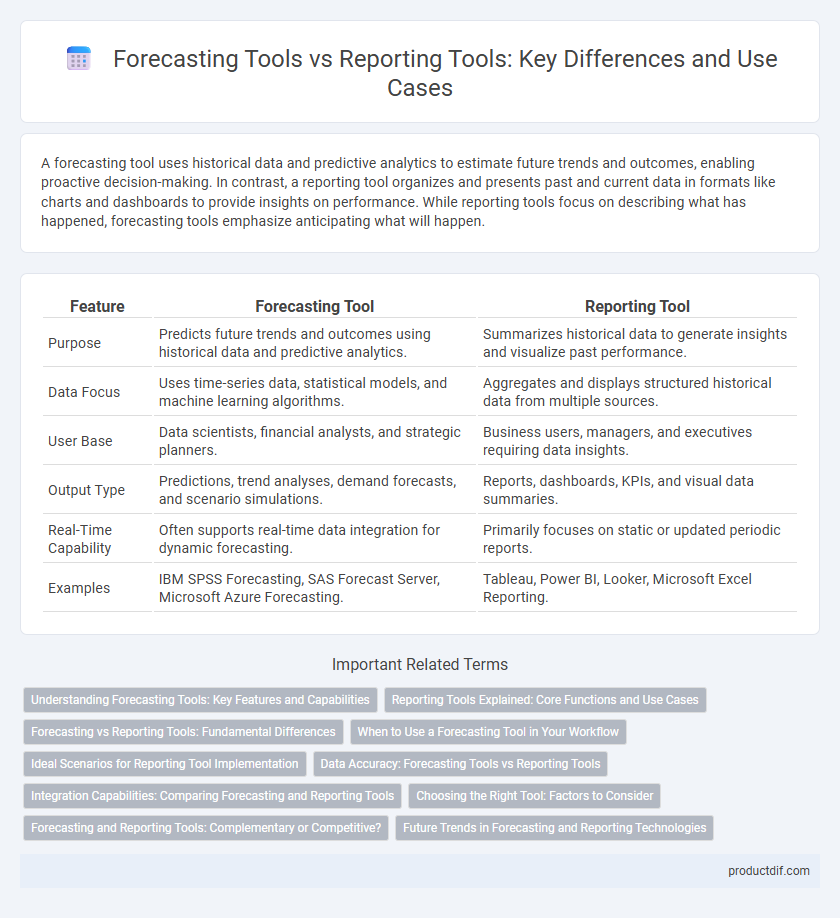A forecasting tool uses historical data and predictive analytics to estimate future trends and outcomes, enabling proactive decision-making. In contrast, a reporting tool organizes and presents past and current data in formats like charts and dashboards to provide insights on performance. While reporting tools focus on describing what has happened, forecasting tools emphasize anticipating what will happen.
Table of Comparison
| Feature | Forecasting Tool | Reporting Tool |
|---|---|---|
| Purpose | Predicts future trends and outcomes using historical data and predictive analytics. | Summarizes historical data to generate insights and visualize past performance. |
| Data Focus | Uses time-series data, statistical models, and machine learning algorithms. | Aggregates and displays structured historical data from multiple sources. |
| User Base | Data scientists, financial analysts, and strategic planners. | Business users, managers, and executives requiring data insights. |
| Output Type | Predictions, trend analyses, demand forecasts, and scenario simulations. | Reports, dashboards, KPIs, and visual data summaries. |
| Real-Time Capability | Often supports real-time data integration for dynamic forecasting. | Primarily focuses on static or updated periodic reports. |
| Examples | IBM SPSS Forecasting, SAS Forecast Server, Microsoft Azure Forecasting. | Tableau, Power BI, Looker, Microsoft Excel Reporting. |
Understanding Forecasting Tools: Key Features and Capabilities
Forecasting tools leverage advanced algorithms and historical data to predict future trends, enabling proactive decision-making and resource allocation. Key features include trend analysis, predictive modeling, scenario simulation, and real-time data integration, which enhance accuracy and adaptability. These tools support strategic planning by transforming raw data into actionable insights, distinguishing them from traditional reporting tools focused primarily on retrospective data presentation.
Reporting Tools Explained: Core Functions and Use Cases
Reporting tools automate the collection, organization, and presentation of data to provide clear insights through dashboards, charts, and detailed reports. Core functions include data visualization, real-time monitoring, and customizable reporting formats that enhance decision-making across business units. Common use cases involve performance tracking, compliance reporting, and operational transparency within industries such as finance, marketing, and supply chain management.
Forecasting vs Reporting Tools: Fundamental Differences
Forecasting tools utilize predictive algorithms and historical data analysis to estimate future trends and outcomes, enabling proactive decision-making and strategic planning. Reporting tools focus on aggregating, visualizing, and summarizing historical data to provide insights into past performance and current metrics. The fundamental difference lies in forecasting tools' forward-looking capabilities versus reporting tools' retrospective analysis.
When to Use a Forecasting Tool in Your Workflow
Use a forecasting tool in your workflow when anticipating future trends, sales, or demand is critical for strategic planning and resource allocation. Forecasting tools leverage historical data and predictive algorithms to generate accurate projections, enabling proactive decision-making. Integrating these tools helps businesses minimize risks and optimize inventory, staffing, and budgeting processes effectively.
Ideal Scenarios for Reporting Tool Implementation
Reporting tools excel in scenarios where historical data analysis and performance tracking are critical for business decisions. They are ideal for generating detailed dashboards, compliance reports, and audit trails that support transparency and accountability. Organizations benefit most from reporting tools when they need consistent, formatted outputs for stakeholders and regulatory requirements.
Data Accuracy: Forecasting Tools vs Reporting Tools
Forecasting tools use predictive algorithms and historical data trends to estimate future outcomes, requiring high data accuracy to produce reliable projections. Reporting tools compile and visualize past and current data, emphasizing precise data collection and validation to generate accurate historical insights. Both tools depend on rigorous data accuracy, but forecasting tools demand additional precision in input assumptions to maintain the validity of predictions.
Integration Capabilities: Comparing Forecasting and Reporting Tools
Forecasting tools excel in predictive analytics by integrating real-time data sources such as CRM, ERP, and market trends, enabling dynamic scenario modeling and proactive decision-making. Reporting tools focus on aggregating historical data from diverse databases and generating customizable dashboards for performance tracking and compliance reporting. Both tool types require seamless integration through APIs and data connectors to ensure accuracy, consistency, and streamlined data flow across enterprise systems.
Choosing the Right Tool: Factors to Consider
Choosing the right tool between a forecasting tool and a reporting tool depends on your business needs, data accuracy, and real-time analytics requirements. Forecasting tools excel in predictive analytics, trend analysis, and future performance projections using historical data and machine learning algorithms. Reporting tools are essential for summarizing past performance, generating dashboards, and providing detailed operational insights needed for strategic decision-making.
Forecasting and Reporting Tools: Complementary or Competitive?
Forecasting tools leverage historical data and predictive analytics to project future trends, enhancing strategic decision-making in dynamic markets. Reporting tools focus on summarizing past and current data, providing comprehensive insights for performance evaluation and operational analysis. Both tools serve complementary roles, where forecasting informs proactive planning while reporting ensures accurate monitoring and accountability.
Future Trends in Forecasting and Reporting Technologies
Forecasting tools utilize advanced predictive analytics and machine learning algorithms to analyze historical data and generate accurate projections, enabling proactive decision-making in dynamic markets. Reporting tools focus on aggregating and visualizing historical and current data to provide actionable insights through customizable dashboards and automated reporting systems. Emerging future trends include the integration of artificial intelligence, real-time data processing, and augmented analytics, which enhance the capabilities of both forecasting and reporting tools by improving accuracy, speed, and user interactivity.
Forecasting Tool vs Reporting Tool Infographic

 productdif.com
productdif.com